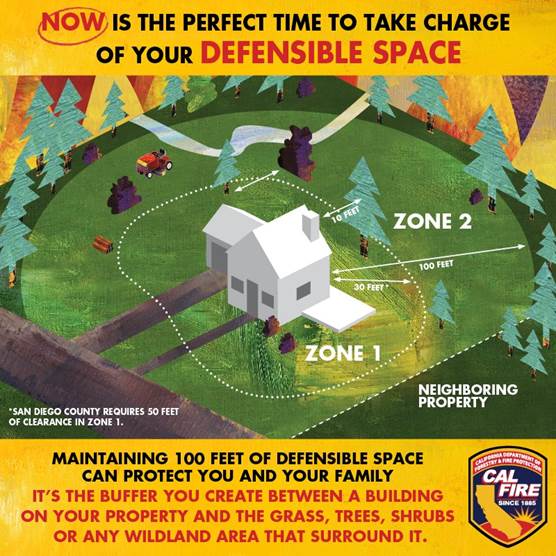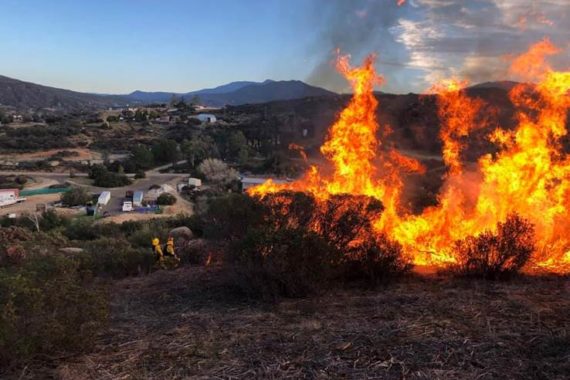Fire Safe Landscaping

By Bob Frey
After a near record setting rainfall this winter, preparing for the upcoming fire season is not a high priority for most homeowners. However, with this abundance of rainfall we see the beautiful hillsides resplendent with green vegetation that will surely turn brown in the early fall. By June this vegetation will serve as a dangerous fuel wick that will rapidly bring any fire into larger shrubs, trees, homes, and businesses. Some hillsides are already showing some signs of dying vegetation.
 Climate change poses a challenge for the potential of significant wildfires in the Southwest and particularly to California. These disruptions are creating higher temperature which have a direct and indirect effect on creating drought conditions. While weather provided an abundance of rainfall this past winter, short- and long-term changes to climate will mean more droughts that will be more severe, and the timing and type of perception we will . There may well be more precipitation in the winter in the Sierra, but it will be in the form of rain and less snow which will result in a diminished snowpack. This will result in more immediate runoff and less storage in the snowpack reducing the gradual release of water in the spring and summer which is critical to fill our reservoirs.
Climate change poses a challenge for the potential of significant wildfires in the Southwest and particularly to California. These disruptions are creating higher temperature which have a direct and indirect effect on creating drought conditions. While weather provided an abundance of rainfall this past winter, short- and long-term changes to climate will mean more droughts that will be more severe, and the timing and type of perception we will . There may well be more precipitation in the winter in the Sierra, but it will be in the form of rain and less snow which will result in a diminished snowpack. This will result in more immediate runoff and less storage in the snowpack reducing the gradual release of water in the spring and summer which is critical to fill our reservoirs.
Another challenge to our communities is the increasing encroachment of homes on the wildland urban interface (WUI). Demand for more housing in San Diego has moved development further into areas closer to native vegetation much of which requires fire for its renewal.
Wildfires require the interaction of three elements: oxygen, fuel, and ignition. Once a wildfire begins, it evaporates moisture in fuels which allows it to travel much more quickly. There’s nothing we can do to diminish oxygen, but we can certainly take action to mange fuels and limit ignition.
Homes catch on fire usually by one of two conditions or a combination of the two. The first is flame impingement where the fire makes direct contact with the structure. The second is burning embers that might well fly a mile or more beyond the front of the fire.
 So, what to do to decrease the danger of flame impingement? Pre-fire management is critical to planning for the fire season. Homeowners should maintain at least 100 feet of defensible space around their structure. This doesn’t mean to have only mineral earth around your home for 100 feet, but rather to follow these suggestions from CalFire:
So, what to do to decrease the danger of flame impingement? Pre-fire management is critical to planning for the fire season. Homeowners should maintain at least 100 feet of defensible space around their structure. This doesn’t mean to have only mineral earth around your home for 100 feet, but rather to follow these suggestions from CalFire:
- Plan your landscape to eliminate a continuous path of vegetation which could well bring the fire directly to your home.
- Use fire resistant plants (no plants are fireproof) and rock, or other hardscape, around the home. With the help of a landscape designer, professionals at a nursery, and online resources can all help to create an attractive landscape that is fire.
- Space trees and shrubs at least 10 feet apart, and chose other plants that grow no more than 18 inches high within the 100 feet defensible .
- Remove lower tree branches within 6 feet of the ground to prevent fire from traveling up and through trees.
- Keep trees trimmed at least 10 feet from any chimney and roof.
- Maintain the landscaping with regular, watering, pruning, and weeding.
What about burning embers? As we know in San Diego County, Santa Ana winds and fire can create a condition that threatens lives and structure. These winds that can approach 80 MPH blowing burning embers a considerable distance from a fire front. These embers can ignite vegetation and invade homes through open windows, roof venting, and any exposed flammable material such as lawn furniture, out buildings, and firewood stacks.
It may seem strange advice, but walk around your home and think like a fire. What would ignite, what would bring the fire to and into your home?
When large and out-of-control wildfires endanger a community, firefighters have to make very fast decisions as to which homes can be protected. Homes that have managed vegetation; that have no exposed, flammable material; and that can be defended without undue threat to the firefighters will be defended to the extent possible. Homes that are deemed to be at greater threat because pre-fire planning has not been accomplished may be passed over by firefighters. These decisions by firefighters may be made within just a couple of minutes under severe conditions.
There is an excellent source of useful information developed by the University of California Cooperative Extension entitled Safe Landscapes: Southern California Guidebook Sustainable and Fire-Safe Landscapes In The Wildland Urban Interface. It’s available at https://ucanr.edu/sites/SAFELandscapes/files/79452.pdf.
Bob Frey is a UCCE San Diego County Master Gardener

